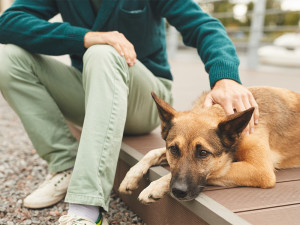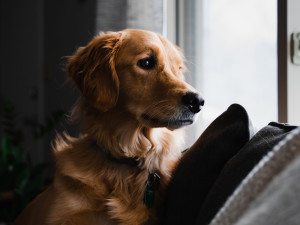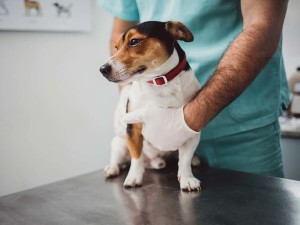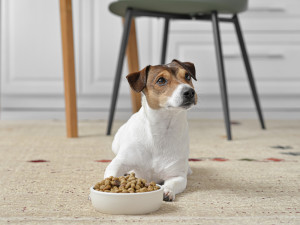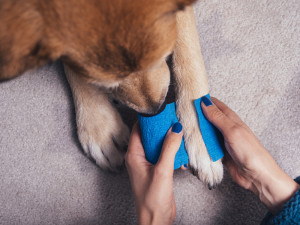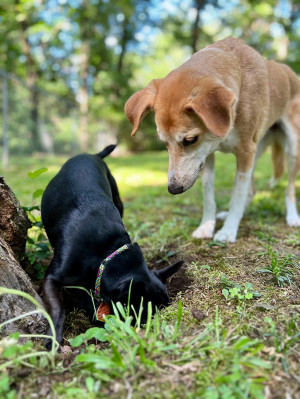My Dog Is Pooping Blood: What Should I Do?
It’s an alarming sight, but here’s what you should know.
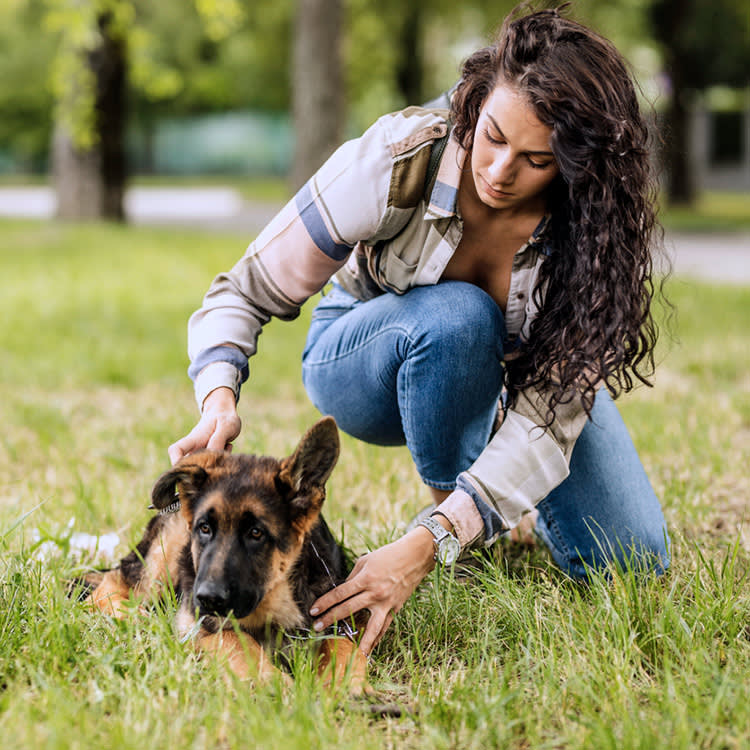
Share Article
In This Article:
Causes of Bloody Dog Poop What Does Bloody Dog Poop Look Like? What Should I Do If My Dog Is Pooping Blood? When Should I Take My Dog to The Vet For Bloody Poop? Treatment Options for Bloody Dog Poop
If you notice blood in your dog’s poop, contact your veterinarian immediately. Blood in a dog’s stool could be a sign of a serious underlying condition, such as parasites, infection, or cancer. The veterinarian will perform a thorough examination and run necessary tests to determine the cause of the bleeding and recommend appropriate treatment.
What are the causes of bloody stool in dogs?
The first thing most dog parents want to know after seeing blood in their dog’s stool is what happened to cause it. Unfortunately, dogs are not great at telling their parents what they got into or when their stomach started to feel upset. Doing some detective work may help you find what caused your dog’s bloody stool, but sometimes the answer remains elusive. Some common causes of blood in a dog’s poop include:
1. Eating something they shouldn’t have
Dogs love to experience their environment by putting anything that smells or looks vaguely interesting in their mouth. These mystery items can sometimes cause stomach upset and result in diarrhea, especially if your dog gets into rotten food. Some dogs also have a sensitive stomach and develop bloody diarrhea from a sudden diet change or a snack of human food. Non-digestible foreign objects can also get caught in the intestines or cause trauma as they move through, resulting in a bloody stool.
How much do you spend on your pet per year?

2. Stress
Stress commonly causes diarrhea in dogs, and this diarrhea can sometimes progress to having blood in it. Staying at a boarding facility is a common trigger for stress diarrhea in dogs, but any change in routine could result in bloody poop. Anxious dogs may not appreciate houseguests, visits to the vet, new dogs in their environment, or home renovations.
3. Parvovirus
Young puppies and unvaccinated dogs are at risk for contracting parvovirus. This virus attacks the cells of the intestines, resulting in vomiting, bloody diarrhea, loss of appetite, and severe illness. This contagious disease comes on quickly and can be deadly, so getting your dog checked at the first sign of a problem with bloody poop is key.
4. Intestinal parasites
Intestinal worms, like hookworms and whipworms, can cause bloody stool in puppies, but they are less likely to affect adult dogs in the same way. However, both puppies and adult dogs are at risk for giardia infections, though. The bacteria Giardia can cause severe diarrhea that often has blood in it. Giardia is contagious to other dogs and people, so getting it treated is extra important.
5. Infection
Unvaccinated dogs can get bloody poop due to viral infections, but bacterial overgrowth can also play a role in bloody diarrhea. Changes in intestinal bacterial populations can result in inflammation that leads to bloody stool.
6. Cancer
Cancer anywhere in the intestinal tract can disrupt the normally smooth, slick surface of the intestines and result in blood in a dog’s stool. These masses may also cause changes in appetite, straining to poop, flattened stool, and discomfort when pooping. Some dogs have no other signs of intestinal cancer, except for blood in their stool.
7. Problems clotting blood
A variety of diseases, such as liver failure, low platelets (due to infection or immune issues), or hemophilia can cause blood clotting issues in dogs. Some rat baits work by making rats unable to clot their blood, and dogs are at risk for the same clotting issues if they get into rat bait. Intestinal bleeding and pooping blood are commonly seen with blood-clotting problems.
What does bloody dog poop look like?
The symptoms of blood in dog stool can vary depending on where in the intestines the bleeding is happening and what disease is causing the bleeding. Some common appearances for bloody dog poop include:
Red blood in or around stool
When describing the blood in their dog’s stool, “jelly-like” is a common term that dog parents use. “Raspberry jam” is a particularly spot-on term for how diarrhea with hematochezia (fresh, bright red blood in stool) might appear. Bright-red blood usually indicates that the blood originates near the end of the intestinal tract (in the colon) because the blood has not had time to be digested.
Black blood in or around stool
Black blood (or melena), often described as “tar-like” in appearance, indicates bleeding near the start of the GI tract. This bleeding can occur in the stomach or upper part of the small intestines due to ulcers, cancer, or blood clotting issues. Seeing a little bit of melena in your dog’s poop usually indicates a lot of bleeding higher up.
Pure red blood with no stool
This is often seen as just a few, isolated drops of blood near where a dog pooped and may be due to straining after defecation (called tenesmus). Dogs often feel the urge to strain after pooping when they have an irritated colon due to diarrhea, foreign material, or constipation. This straining can disrupt the surface of the colon, resulting in a small amount of bleeding. While a large amount of bleeding is possible with certain cancers or bleeding issues, it’s much more common to see dogs pooping bloody mucus than straight blood.
What should I do if my dog is pooping blood?
If you see blood in your dog’s poop, there are a few ways to check and see if a cause can be found. A trigger for the bloody stool is not obvious in many cases, but you should still investigate so that nothing is missed. Go over your dog’s recent behaviors and be on the lookout for things like:
Evidence of getting into garbage, people food, or something unusual outside
Recent stressors
Possible exposure to toxins, including rat bait
Wounds or swellings around the rear end or anus
Recent diet change
Any bruising or other bleeding
Other symptoms, especially vomiting or changes in appetite
If you see blood in your dog’s poop, contact your vet’s office. Because some of the causes of bloody poop in dogs are very serious, they’re the best ones to guide you on the steps to take. They will want to know about the additional information you’ve gathered and how your dog is acting since symptoms began.
When should I take my dog to the vet if they are pooping blood?
Taking your dog to the vet if you see blood in their poop is generally the best idea. Discuss the problem with them, and schedule an appointment as soon as possible to have them assessed. Emergency treatment may be needed if the bloody poop is accompanied by other symptoms like:
Lethargy
Weakness or collapse
Vomiting
Frequent diarrhea
Loss of appetite
Pale gums
Other bruising or bleeding
Known exposure to a toxin
Difficulty breathing
Unproductive straining to defecate
Abdominal pain
How do vets diagnose the cause of blood in dog stool?
The most common cause of bloody poop in dogs is a condition called acute hemorrhagic diarrhea syndrome (AHDS), formerly known as hemorrhagic gastroenteritis (HGE). This syndrome encompasses many possible causes for diarrhea and is often assumed when other conditions like parasites and cancer have been ruled out.
In addition to performing a physical examination, veterinarians will often perform a variety of tests to rule out some causes of blood in a dog’s stool and to determine how severely a dog is affected. These tests can include:
Bloodwork to assess dehydration and check to make sure the blood clots properly
Fecal testing to check for parasites
Abdominal imaging (ultrasound or radiographs) to look for masses or foreign objects
Viral testing to rule out some contagious diseases
How do vets treat dogs who are pooping blood?
The treatment for a dog pooping blood depends on the cause. Dogs with parasites will need dewormers or medications to treat giardia. Dogs with blood clotting issues may need blood or plasma transfusions, steroids, or vitamin K1 to treat the underlying cause. Viral diseases and AHDS are usually treated with supportive care.
Bloodwork helps to determine how aggressive supportive care will need to be. Dogs without significant dehydration that seem to be doing well otherwise may be treated with basic outpatient care like subcutaneous fluids, anti-nausea medications, and recommendations for changes at home. Dogs that are dehydrated or feeling very ill are often hospitalized for IV fluids, anti-nausea medications, and additional therapies.
Antibiotics used to be prescribed frequently for bloody diarrhea but are now commonly reserved for very sick dogs with symptoms like fever, a low white blood cell count, or a failure to respond to basic treatment. Overuse of antibiotics can contribute to antibiotic resistance and future health problems for your dog, so limiting their use to known infections is vital.
Are there home remedies for dogs pooping blood?
Most dogs will go home with recommendations for home care as they recover from bloody diarrhea. Some common home-care remedies include a bland diet (either a pre-made prescription diet or a chicken-and-rice diet), probiotics made specially for dogs, and lots of rest and TLC. For dogs with bloody diarrhea, keeping their rear end clean can help to prevent problems with skin irritation and infections.
Will my dog recover if they are pooping blood?
Most dogs with bloody poop will bounce back well with treatment, often within a few days. Dogs with more serious conditions like bleeding issues, cancer, or parvovirus infections have a more guarded prognosis. There are still treatment options available for these problems, but the length and complexity of care will be greater.
Are there ways to help avoid blood in dog feces?
The keys to avoiding bloody stool for your dog are centered around preventative care and avoiding triggers. Young puppies should be vaccinated and dewormed per your veterinarian’s instructions. They should also not meet unknown dogs or play in shared areas (like dog parks) until they are fully vaccinated. Adult dogs should stay on the recommended vaccine schedule and be on monthly preventatives to prevent intestinal parasites. Don’t let your dog drink untreated water and do your best to keep them from eating garbage and other found objects.
FAQs (People also ask):
Can my dog die from pooping blood?
Bloody poop can be an indicator for a number of serious conditions like parvovirus, bleeding problems, cancer, and acute hemorrhagic diarrhea syndrome. These diseases can be deadly, and dogs that are pooping blood can get sick quickly.
Is there a specific diet for a dog with bloody stools?
A bland diet is often recommended to help dogs recover from having bloody stool. The is not the answer for every dog with bloody stool though, because some causes of blood in poop are more serious and will not respond to diet change alone.
What are the types of diseases that can cause blood in a dog’s poop?
Dogs can develop bloody poop for a variety of reasons, including viral or bacterial infections, dietary indiscretion, cancer, toxins, and blood clotting disorders.
How do I know if my dog’s poop is normal?
Normal dog stool should be light to dark brown in color and formed. It should not fall apart or change shape easily when picked up. It may have a thin, slick, clear coating of mucus on the surface, but it should not have any evidence of blood in or on it.
References

Dr. Bartley Harrison, DVM
Dr. Bartley Harrison is a veterinarian with more than 19 years of experience. He has treated a variety of species in emergency and speciality practices for both large and small animals. His primary interests as a vet are emergency medicine and critical care.
Related articles
![feeding black dog rice water to help relieve diarrhea]()
Vet-Approved Diarrhea Treatments
Shudder. It happens to all of us.
![A dog getting checked out at the vet]()
What to Expect At the Emergency Vet
It's every pet parent's nightmare — but knowing what happens when you take your dog to the ER can make the experience a little less stressful.
![A dog sitting on the floor with a bowl of kibble.]()
Everything You Need to Know About Your Dog’s Gut Microbiome
Microscopic organisms may reveal pathways to better health for your pet.
![bandaging dog's bleeding paw]()
How to Care for Your Bleeding Dog
Don’t freak out—here’s what to do.
![Adorable dog sitting on a rug next to some boots scooting]()
Scooting After Pooping: Weird Things Dogs Do Explained
Dog trainer Emma Bowdrey helps explain this common canine behavior.
![Two dogs digging outside in the dirt.]()
Types of Worms in Dogs: How to Detect and Treat Worms in Dogs
Here are the types of worms your pup could get, how you know they have them in the first place, and how to get rid of them for good.


